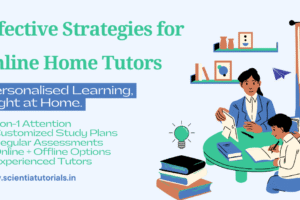Bringing Learning to Life: Teaching Tips for Home Tutors on Using Real-World Examples to Teach Complex Topics
Introduction
Teaching complex topics can be a challenging task for home tutors. Whether it’s abstract mathematical concepts, scientific theories, or difficult literary analysis, students often struggle to relate to or fully grasp these subjects. One of the most effective ways to break down these barriers is by using real-world examples. By making connections between the lesson material and the everyday world, tutors can make learning more accessible, engaging, and memorable.
This article explores practical strategies for home tutors to incorporate real-world examples into their lessons, helping students to better understand and retain complex topics. We will look at the benefits of this teaching approach and offer concrete examples across different subjects, helping you bring learning to life in your tutoring sessions.
1. The Power of Real-World Learning
How Real-World Examples Make Learning Relevant
Using real-world examples in teaching transforms abstract ideas into tangible experiences, giving students context and making learning more relevant. Instead of memorizing information, students are able to see how their lessons apply to everyday situations, deepening their understanding.
Why Real-World Learning Works:
- Enhances Engagement: When students can relate a topic to something they encounter in their daily lives, they become more interested and engaged.
- Boosts Retention: Real-world examples help solidify knowledge by linking it to meaningful, familiar experiences, improving long-term retention.
- Encourages Critical Thinking: Applying lessons to real-world scenarios encourages students to think critically and problem-solve.
- Bridges Theory and Practice: It helps students see the practical applications of theoretical knowledge, making learning more functional and less abstract.
Whether it’s understanding how geometry works in construction or how ecosystems function in nature, real-world examples can turn complex topics into lessons that resonate with students.
2. Teaching Math with Real-World Applications
Making Math Concepts Accessible Through Everyday Examples
Math can often seem daunting and abstract to students, particularly when dealing with advanced topics such as algebra, geometry, or calculus. One of the best ways to help students understand complex mathematical concepts is to relate them to real-world applications.
Examples of Using Real-World Scenarios to Teach Math:
- Geometry in Architecture: When teaching geometry, you can use the layout and design of buildings and homes to illustrate angles, shapes, and symmetry. Ask students to identify geometric shapes in their surroundings or measure angles in objects.
- Algebra in Shopping: Use budgeting and shopping scenarios to teach algebraic equations. For example, if a student needs to buy multiple items with a limited budget, ask them to create an equation that represents the cost of different items and how they can adjust their purchases to fit the budget.
- Statistics in Sports: Sports provide a wealth of data for teaching statistics and probability. You can discuss batting averages, game scores, or player statistics to explain these concepts in a way that feels relevant to students who enjoy sports.
By applying math to real-life contexts like construction, personal finance, and data in sports, tutors can show students that math is not just a series of numbers but a tool used in everyday decision-making and problem-solving.
3. Science Through the Lens of Everyday Life
Connecting Scientific Concepts to Real-World Phenomena
Science can sometimes feel distant or difficult to relate to for students, especially when covering complex topics like physics, chemistry, or biology. Using everyday occurrences as a foundation for these subjects helps students better understand how the principles of science impact their daily lives.
Real-World Examples to Teach Science:
- Physics in Motion: Everyday objects in motion, such as bicycles, cars, or swings, provide excellent opportunities to teach concepts like force, acceleration, and gravity. For example, explain the physics of a swing by discussing potential and kinetic energy in action.
- Chemistry in Cooking: Cooking is a great way to explain chemical reactions. Show how baking a cake involves transforming ingredients through heat, similar to how chemical reactions transform substances. This real-life application makes abstract concepts like temperature, molecules, and reactions easier to grasp.
- Biology in Health: Use real-world examples from health and nutrition to teach biology. Discuss how the human body processes food or the importance of vitamins and minerals. You can also link biology lessons to current events, such as how vaccines work to combat diseases.
Connecting scientific theories to real-life examples helps students move beyond rote memorization of facts, encouraging them to explore and experiment with the world around them.
4. Using Literature and History to Relate to Real-World Events
Bridging Literature and History Lessons with Modern-Day Issues
Literature and history offer many opportunities to connect past events or fictional stories with real-world issues, encouraging students to think critically about the human experience. These subjects allow students to draw parallels between what they learn in textbooks and the events and issues they see in the world today.
Relating Literature to Modern-Day Experiences:
- Character and Plot in Real Life: When analyzing characters in a novel, ask students to draw comparisons between the characters’ dilemmas and modern-day challenges. For example, themes of power, freedom, and social justice in classic literature can often be linked to current societal issues.
- Symbolism in Fiction: Help students understand the use of symbolism in literature by connecting symbols in books to real-world items or events. For example, you can discuss how a storm in a novel symbolizes inner turmoil, similar to how personal struggles manifest in real life.
Bringing Historical Events into Contemporary Context:
- Linking History to Current Events: When teaching history, use real-world parallels to help students see how the past shapes the present. For instance, while discussing major historical movements like civil rights, connect these events to current global issues like social justice movements, showing the continuity of certain struggles.
- Personalizing Historical Narratives: Encourage students to think about how historical events would have affected people like them in their local community. This personal connection can help make history more relatable and engaging.
Through the use of real-world connections in literature and history, tutors can make these subjects feel more immediate and relevant, encouraging students to think more deeply about their lessons.
5. Real-World Problem Solving for Critical Thinking
Developing Critical Thinking Skills Through Practical Applications
Critical thinking is an essential skill in mastering complex subjects. Using real-world problem-solving exercises encourages students to think independently, apply their knowledge in practical ways, and develop decision-making skills.
Teaching Critical Thinking Through Real-World Examples:
- Scenario-Based Learning: Present students with real-world problems and ask them to come up with solutions. For example, if teaching environmental science, ask students how they would reduce waste in their community, or if teaching economics, have them devise a plan to manage a family budget.
- Debates on Current Issues: Engage students in debates or discussions about current events or ethical dilemmas. This not only sharpens their critical thinking skills but also helps them learn how to form and articulate reasoned opinions.
By integrating real-world problem-solving into lessons, tutors can foster independent thinking and give students the confidence to tackle challenging issues both in and out of the classroom.
6. Using Technology to Enhance Real-World Learning
Incorporating Digital Tools and Resources
Technology provides home tutors with countless resources to bring real-world examples into their lessons. By utilizing online tools, multimedia resources, and interactive simulations, tutors can make complex topics more engaging and easier to understand.
Technological Tools for Real-World Learning:
- Virtual Simulations: Online simulations can bring scientific experiments, historical events, or complex math problems to life. Students can explore virtual labs, manipulate variables, and see real-time results, making abstract concepts more concrete.
- Multimedia Resources: Use documentaries, videos, and articles from credible sources to connect students with real-world events. For example, a documentary on climate change can complement a lesson on environmental science, showing the practical effects of the subject matter.
- Interactive Learning Platforms: Tools like Khan Academy, Google Earth, and Coursera allow students to explore topics in depth through interactive maps, lessons, and problem-solving exercises that are connected to real-world scenarios.
Incorporating technology into your tutoring sessions helps students see the relevance of their learning in a digital age, while also making lessons more dynamic and interactive.
7. Personalizing Lessons for Greater Impact
Tailoring Real-World Examples to Your Student’s Interests
One of the greatest benefits of home tutoring is the ability to personalize lessons. You can take this a step further by choosing real-world examples that align with your student’s interests and passions. This not only makes the material more relatable but also enhances student engagement and motivation.
How to Personalize Real-World Examples:
- Link to Hobbies or Interests: If your student loves video games, use game design principles to teach coding or math. If they are passionate about sports, use game strategies to explain statistics or probability.
- Connect to Career Goals: For older students, linking lessons to their future career aspirations can make the material more meaningful. For instance, if your student wants to become a doctor, use medical examples to explain biology and chemistry concepts.
Personalizing real-world examples makes learning more fun and relevant, helping students to engage with and better understand complex topics.
Conclusion
Incorporating real-world examples into your tutoring sessions is a powerful strategy for making complex topics more understandable and engaging. By connecting abstract concepts to everyday experiences, home tutors can help students bridge the gap between theory and practice, fostering deeper learning and critical thinking. Whether you’re teaching math, science, literature, or history, the world around us offers countless opportunities to illustrate and reinforce your lessons.
By using the tips outlined in this article, home tutors can enrich their teaching, making learning not just an academic exercise but a practical, real-world skill.



